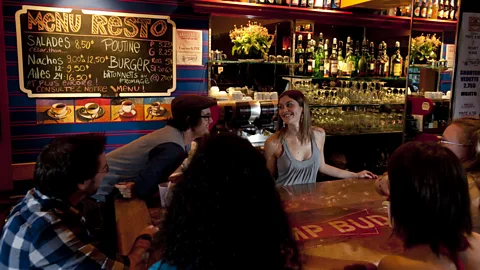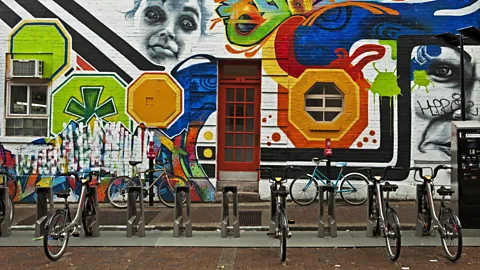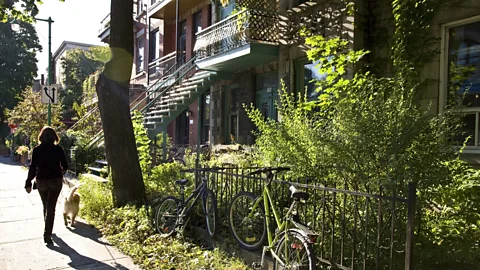Living in: Montreal

Home to friendly locals and a thriving nightlife, this Canadian metropolis is surprisingly affordable and only a short drive from the great outdoors.
With a minimum drinking age of 18 and a nonstop nightlife traditionally capped off with a 3am poutine stop, Montreal doesn’t shy away from being “the party city of Canada”. On top of its lively bars, clubs and restaurants, the city is home to fun-loving, trendsetting locals who ensure the place never gets dull.
“The vibe edges on the weird side,” said Michael D'Alimonte, head writer for MTL Blog, an online arts and culture site. “Montrealers won't bat an eye if they were to see a grown man in a full clown costume walking around the mall.”
Even though the city’s residents might at first seem to keep to themselves, they can be quite friendly. “Montrealers are extremely welcoming of visitors and tend to be quite talkative given the occasion,” said Marie-Eve Vallières, a Montreal native who writes the blog A Montrealer Abroad. “They enjoy sharing their love of the city with anyone who asks. A sincere ‘Bonjour!’ is always a good start.”

Indeed, French is the city’s official language, with 63% of residents claiming it as their first language in the 2011 census; in fact, Montreal is the second-largest French speaking city after Paris. Still, more than half the population speaks English, so visitors should have no problem navigating the city. Expats will find life easier if they learn French, especially if they plan to work in the city; local law requires workers to competently speak the language.
Where do you want to live?
Where you want to live really depends on whether you plan to speak primarily English or French. “Montreal always had a clear distinction between its French- and English-speaking communities,” Vallières said. “Even though the lines are definitely more blurred nowadays, the tradition still remains.” French speakers stick to the neighbourhoods of family-friendly Outremont, tree-lined Plateau Mont-Royal, community-oriented Rosemont-Petite-Patrie and the recently rejuvenated Hochelaga-Maisonneuve, while English-speaking expats tend to live in “opulent” Westmount, hipster-approved Mile End, Notre-Dame-de-Grace (NDG for short), and quiet Lasalle.
Boulevard Saint-Laurent acts as an unofficial buffer zone between the two linguistic communities where both languages are readily spoken. D'Alimonte recommended that English speakers who don’t speak French stick closer to the downtown areas near Saint-Laurent, including Mile End and the lower Plateau, “arguably the trendiest area of the city, where no one really minds if you speak English”.
What do you want to live in?
Montreal has many residences in buildings that are well over 100 years old. And while most Montrealers live in one of these charmingly historic houses – three- to four-storey buildings often referred to as “plexes” – at one time or another, the creaky wood floors and lack of soundproofing mean most end up moving to more modern condos or apartments eventually.

One distinctive feature of these old buildings is outdoor staircases, which give the places an appealing “old-school” look, but residents are quick to point out the challenges of shovelling snow off them in negative 30C weather.
Houses are found in the suburban boroughs and tend to be shared among renters. In fact, locals recommend expats don’t venture beyond the city limits when looking for a place to live. “The Montreal suburban life doesn't present a lot of advantages, as it isn't cheaper, simpler to navigate or friendlier,” Vallières said. “Quite the opposite, in fact!”
Where can you travel?
From Montreal’s Pierre-Trudeau Airport, you can fly to New York, Toronto, and Washington D.C. in around an hour. The closest city within driving range is Ottawa, 200km to the west, but residents looking for a weekend getaway often drive 250km northeast to European-feeling Quebec City.
Still, Vallières said it’s easier to stay relatively local and explore the Québécois countryside. About 150kms to the east, the Eastern Townships are distinguished by their English-influenced architecture built by American loyalists who moved north after the American Revolution; the area is known for its vineyards. The dense forests of the Laurentians region, only 70kms north of Montreal, make a good day trip for Nordic and downhill skiing and other outdoor activities.
How much does it cost?
Montreal remains surprisingly affordable for a major metropolitan city. “Renting a room should never cost you more than $500 to $600 per month, unless it is seriously swanky and in Old Montreal,” D’Alimonte said. Even buying is a viable option here, with a standard two-bedroom condo costing around $300,000 and no restrictions on foreigners owning property.

Residents can easily get by without a car. “Between the miracle of actually finding parking, dealing with notoriously complex regulations and snow-plowing schedules, and excessive fines, driving in this city is definitely more of a handicap than anything else,” Vallières said. A monthly metro card for the efficient underground subway costs only $80 a month, and car-sharing services make it easy to snag a ride.
The large student population here means it’s easy to find good deals on groceries and food, too. And while liquor purchased in restaurants comes with high taxes, many restaurants allow diners to bring their own, which keeps bills down.
